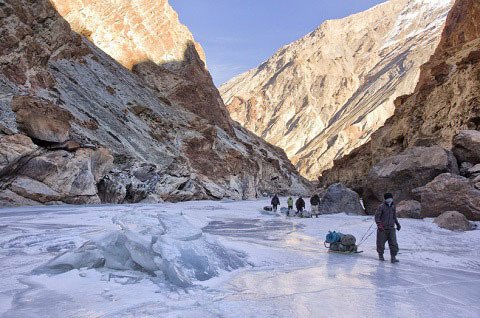Artificial lake on Phutkal in Kargil bursts
Putkal lake

SRINAGAR : Despite claims of 'normalcy' by the Indian Army as well as the State government, an artificial lake formed in January on Phutkal river breached on Thursday, triggering flash-floods that washed away several bridges and damaged agricultural land in Zanskar region of Ladakh.
Officials said the 12-km long artificial lake breached at around 8:30 on Wednesday morning, affecting at least four villages living downstream of Phutkal and damaging six foot-bridges, three motorable bridges, a school building and hundreds of acres of agricultural land.
Residents of the villages settled on the banks of the river including Ichar, Padum, Tipting, Chah and Pipcha reacted promptly and abandoned their homes, preventing any loss of life.
Joint teams of police, Army, National Disaster Response Force (NDRF) reached the spot to keep an eye on the flow of water.
"The situation is under control now. The water has receded from most areas and people have returned to their homes," Mohammad Haneefa Jan, Chairman of Ladakh Autonomous Hill Development Council (Kargil), told The Citizen over phone.
He said the government will carry out assessment of the losses suffered by the villagers and they would be adequately compensated.
A massive landslide came down into the river on January 15 this year, blocking its normal flow and forming an artificial lake containing over 30 million cubic meters of water which kept increasing with every passing day.
A team of National Crisis Management Committee visited the area soon after the landslide occurred and declared the situation as a "national crisis" in February.
A high-level team of experts from National Disaster Management Authority (NDMA) conducted survey on Phutkal on February 18 and submitted its report to the Government of India, recommending controlled blasting of the blocked stretch and digging a channel to release the accumulated water.
Later, the Indian Army in coordination with the state administration and NDMA launched "Operation Phutkal" for creating a breach in the artificial lake.
"A detailed survey was carried out and it was decided to carry out controlled blasting in the landslide. The Indian Army was called upon and a Composite Task Force comprising specially selected and trained personnel from the Army, Air Force, NDMA and state administration was formed to execute the task," a statement issued by the Army in April said.
It said a 75 metre-long channel, two metre deep and two metre wide was created that facilitated flow of water to the downstream side. "Water finally started gushing across the landslide in an uninterrupted manner from the lake formed. Due to the joint and synergised efforts of the Army, Air Force, NDMA and the civil administration, a major calamity was averted and precious lives saved," it said.
However, the breach on Thursday has left the state administration as well as the Army red-faced. Although the water from the artificial lake has crossed the small town of Padum, the headquarters of Zanskar sub-division of Kargil district, and the worst is over, LAHDC chairman Mohammad Haneefa raised questions about the claims made by the Army.
"The Army claimed to have averted the crisis in April. We are not able to understand what went wrong. They had declared that there was no crisis. It must be investigated what went wrong. They (Army) have not given any reasons," he said.
Aga Syed Muhammed Baqir Rizvi, who represents Zanskar in the state legislature, also demanded an inquiry into the incident, "The NDMA took inadequate measures to control the situation. An enquiry must be launched into the amount of funds spent on creating the so called channel in the lake,” Rizvi said.
A senior Army official, who didn't want to be named, said the increase in temperature across the state resulted in quick melting of glaciers which brought excess water into the lake.
"The lake was not able to hold the excessive discharge from the glaciers due to summers, which resulted in the breach. Thankfully, no lives have been lost," the official said.



